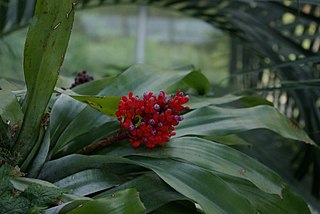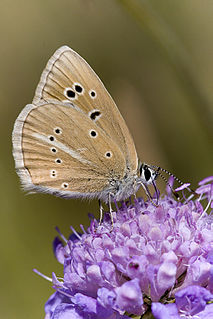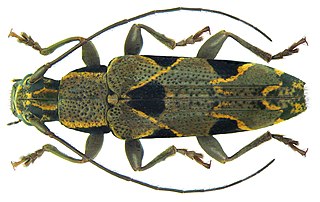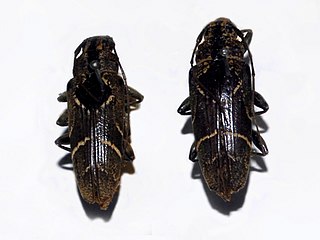
The red panda is a carnivoran native to the eastern Himalayas and southwestern China. It is listed as Endangered on the IUCN Red List because the wild population is estimated at fewer than 10,000 mature individuals and continues to decline due to habitat loss and fragmentation, poaching, and inbreeding depression. Despite its name, it is not closely related to the giant panda.

Ailuridae is a family in the mammal order Carnivora. The family consists of the red panda and its extinct relatives.

Rivoli's hummingbird is a large hummingbird. It was usually considered the only member of the genus Eugenes and is also called the magnificent hummingbird. Many taxonomic authorities, such as the International Ornithological Committee, split the northern nominate subspecies E. f. fulgens from the larger southern race of Costa Rica and Panama, E. f. spectabilis, into distinct species, in which case the nominate fulgens is renamed Rivoli's hummingbird and spectabilis is named the Talamanca hummingbird or admirable hummingbird.

Aechmea fulgens, the coralberry, is a bromeliad, which is often used like an ornamental plant. This plant grows in Brazil, especially in following states: Bahia and Pernambuco.

Metrosideros fulgens is a forest liana or vine endemic to New Zealand. It occurs in coastal and lowland forest throughout the North Island, on the west coast of the South Island and on the Three Kings Islands north of Cape Reinga. It is one of a number of New Zealand Metrosideros species which live out their lives as vines, unlike the northern rata (M.robusta), which generally begins as a hemi-epiphyte and grows into a huge tree. Scarlet rātā is one of the better-known species of rātā vines, because it flowers in autumn or winter, and is often highly visible on well-lit host trees along forest roads, with vibrant displays of large red flowers that rise above the forest canopy.

Fulgens corona is an encyclical by Pope Pius XII, given at St. Peter's, Rome, on 8 September 1953, the Feast of the Nativity of the Blessed Virgin Mary, in the fifteenth year of his Pontificate. The encyclical proclaims a Marian year for 1954, to commemorate the centenary of the definition of the dogma of the Immaculate Conception of the Virgin Mary.

Caloscypha is a fungal genus in the family Caloscyphaceae. A monotypic genus, it contains the single species Caloscypha fulgens, commonly known as the spring orange peel fungus, the golden cup, or the dazzling cup. It is a cup fungus, typically up to 4 centimetres (1.6 in) in diameter, with a bright to pale orange interior and orange; specimens that are old or bruised often have an olive-green discoloration, especially around the edges. In North America, it is usually found on the ground in forest litter near conifers. Fruiting occurs in early spring following snow melt. The asexual (imperfect), or conidial stage of C. fulgens is the plant pathogenic species Geniculodendron pyriforme, known to infect dormant seeds of the Sitka spruce.

Melaleuca fulgens, commonly known as the scarlet honey myrtle, is a plant in the myrtle family Myrtaceae, and is endemic to Western Australia, South Australia and the Northern Territory. It is notable for its showy orange, red or purple flowers, unusual foliage and fruit, and is a popular garden plant. It is a member of Melaleuca, a large and diverse genus whose members range from large trees such as M. quinquenervia, to small shrubs.

Haliotis fulgens, commonly called the green abalone, is a species of large sea snail, a marine gastropod mollusc in the family Haliotidae, the abalones. The shell of this species is usually brown, and is marked with many low, flat-topped ribs which run parallel to the five to seven open respiratory pores that are elevated above the shell's surface. The inside of the shell is an iridescent blue and green.

Ovachlamys fulgens is a species of air-breathing land snail, a terrestrial pulmonate gastropod mollusk in the family Helicarionidae.

Polyommatus (Agrodiaetus) fulgens is a species of butterfly in the family Lycaenidae. It is found in the north and north-east of Spain.

Tmesisternini is a tribe of beetles in the subfamily Lamiinae containing the following genera:

Tmesisternus is a genus of longhorn beetles belonging to the family Cerambycidae, subfamily Lamiinae.
The Seram long-tailed mosaic-tailed rat, also known as the Seram long-tailed melomys, is a species of rodent in the family Muridae. It is found only on the south coast of the island of Seram in Indonesia. At one time it was thought to be a subspecies of the white-bellied mosaic-tailed rat but was subsequently raised to full species level. It differs from that species in having a much longer, scale-free tail with a calloused tip which is likely to be prehensile and used while climbing trees.
Grevillea fulgens is a shrub of the genus Grevillea native to a small area along the south coast in the Goldfields-Esperance region of Western Australia.
Tmesisternus jaspideus is a species of beetle in the family Cerambycidae. It was described by Jean Baptiste Boisduval in 1835.
Tmesisternus schaumii is a species of beetle in the family Cerambycidae. It was described by Francis Polkinghorne Pascoe in 1867. It is known from Moluccas, Australia, and the Solomon Islands.

Heliophanillus fulgens is a jumping spider species in the genus Heliophanillus that can be found in a large distribution that extends from Greece to Central Asia.

The Talamanca hummingbird or admirable hummingbird, is a large hummingbird. Some taxonomic authorities, such as the International Ornithological Committee, split the magnificent hummingbird into two species, in which case the nominate subspecies fulgens is renamed Rivoli's hummingbird and spectabilis is named the admirable hummingbird. Other taxonomic authorities have not recognized the split. The talamanca hummingbird's range is Costa Rica to Panama.
Leucospermum fulgens is an evergreen, upright shrub of up to 3 m (10 ft) high, from the family Proteaceae. It has hairless and leathery inverted lance-shaped to oblong leaves tipped with mostly three teeth and globe- to egg-shaped flowerheads of 6–8 cm in diameter, that consist of pink to orange, later crimson flowers. From the center of the flowers emerge almost straight styles that jointly give the impression of a pincushion. It is called Potberg pincushion in English. New pink to orange flower heads occur between August and November, but older, crimson heads may persist until January. It is a critically endangered species, only known from one location in the Western Cape province of South Africa.














